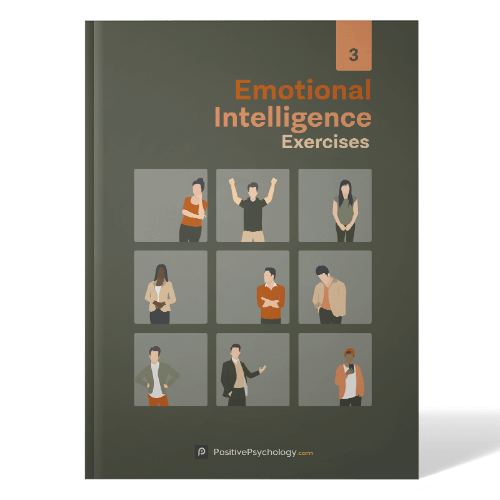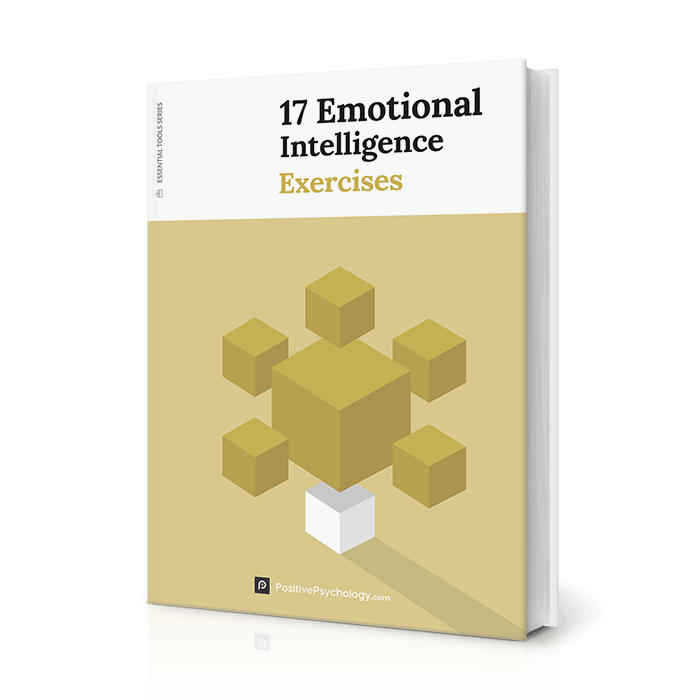What is the Positive and Negative Affect Schedule? (PANAS)
 The Positive and Negative Affect Schedule or (PANAS) is a scale that consists of different words that describe feelings and emotions. (Magyar-Moe, 2009).
The Positive and Negative Affect Schedule or (PANAS) is a scale that consists of different words that describe feelings and emotions. (Magyar-Moe, 2009).
One of these scales measures positive affect, and the other measures negative affect.
Positive affect refers to the propensity to experience positive emotions and interact with others positively, even through the challenges of life.
Negative affect, on the other hand, involves experiencing the world in a more negative way.
This might also occur if you tend to feel negative emotions and act more negatively within your relationships or your surroundings.
While these two states are on opposite ends of the spectrum, both states affect our lives and how we live.
In this article, we will review the idea of Positive and Negative Affect in terms of the Positive and Negative Affect Schedule or PANAS.
Before you read on, we thought you might like to download our three Emotional Intelligence Exercises for free. These science-based exercises will not only enhance your ability to understand and work with your emotions but will also give you the tools to foster the emotional intelligence of your clients, students, or employees.
This Article Contains:
What is the Positive and Negative Affect Schedule?
There are many self-reported measures available to help practitioners identify client strengths and symptoms of wellbeing. (Magyar-Moe, 2009).
Many of these measures are quick to administer and score and available online. Some of the instruments available measure things like character strengths, life satisfaction, positive emotions, and even coping skills. The PANAS measures positive and negative affect.
The PANAS has been widely utilized as a self-reported measure of affect in both the community and clinical contexts. (Merz et al., 2013).
It is used as a psychometric scale that is intended to show the relationship between positive and negative affect within certain personality traits.
When using the PANAS, participants gauge their feelings and respond via a questionnaire with 20 items. A 5-point Likert scale is then used for scoring.
Clinical studies, as well as non-clinical ones, have found PANAS to be a valid and reliable assessment tool for gauging positive and negative affect. (Merz et al., 2013).
The PANAS was developed in 1988 by psychologists David Watson, Lee Anna Clark, and Auke Tellegen. (Mulder, P., 2018).
The scale intends to measure someone’s positive and negative affect and how a person is feeling at the moment.
What Does it Measure Exactly?
The term affect is a very fancy way of talking about emotions and expressions. It refers to the emotions or feelings that you might experience and display, in terms of how these emotions influence you to act and make decisions.
Positive affectivity refers to positive emotions and expressions such as joy, cheerfulness, or even contentment.
Negative affectivity, on the other hand, refers to negative emotions and expressions such as anger, fear, or sadness.
We often assume that these two things are on opposite ends of the scale, but that is not necessarily so.
For example, you might feel positive affect toward a friend who recently got promoted, but at the same time feel some degree of negative affect because of jealousy.
The PANAS measures both positive and negative emotions for clients from week-to-week as they engage in everyday life. (Magyar-Moe, 2009).
It can also be used as a tool for charting the immediate effects of therapy as well as any outcomes associated with positive psychological exercises, interventions or activities.
The scale is sensitive to momentary changes in affect when clients are directed to complete the form based on their affect at the present moment.
Participants utilizing PANAS use a 5-point scale in which they determine if a concept applies. (Mulder, P., 2018).
- Very Slightly or Not at All.
- A Little.
- Moderately.
- Quite a Bit.
- Extremely.
The final score is derived out of the sum of the ten items on both the positive and negative side.
The PANAS is designed around 20 items of affect. The scale is comprised of several words that describe different emotions and feelings. (Magyar-Moe, 2009).
Clients are instructed to read each item and then list the number from the scale next to each word.
The intent is to indicate to what extent they feel these emotions at the moment or how they felt over the past week. Terms used in the scale are as follows:
- Interested
- Distressed
- Excited
- Upset
- Strong
- Guilty
- Scared
- Hostile
- Enthusiastic
- Proud
- Irritable
- Alert
- Ashamed
- Inspired
- Nervous
- Determined
- Attentive
- Jittery
- Active
- Afraid
Scores can range from 10 to 50 for both the Positive and Negative Affect, with the lower scores representing lower levels of Positive/Negative Affect and higher scores representing higher levels of Positive/Negative Affect. (Watson, D., Clark, L. A., & Tellegan, A., 1988).
PANAS scale – EPM
A Look at the Validity
The PANAS displays a very good internal reliability that is consistent with Cronbach alpha coefficient scores ranging from 0.86 to 0.90 for the Positive Affect Scale and 0.84 to 0.87 for the Negative Affect Scale (Magyar-Moe, 2009).
This level of consistency is found no matter what time instruction is utilized. Test-reliability was found to be good, over a timeframe of 8 weeks.
The reliability of the test seems to be a little higher as the time frame lengthens and when used with instructions such as right now or over the past week.
Convergent validity was found between the Positive Affect subscale of the PANAS and measures of social activity and diurnal variation in mood.
Discriminant validity was found between the Positive Affect subscale and measures of stress, aversive events, dysfunction, depression, and general distress.
The opposite was true for the Negative Affect subscales. Convergent validity was established between Negative Affect and measures of stress, aversive events, depression, and general distress and dysfunction, and discriminant validity with measures of social activity and diurnal variation in mood (Watson et al., 1988).
According to Watson & Clark (1999), PANAS-X scales, a more developed and refined version of the test, can be used validly to assess long-term individual differences in affect. Further observations showed that PANAS-X scales are:
- Stable over time.
- Show significant convergent and discriminate validity when correlated with peer-judgments.
- Highly correlated with corresponding measures of aggregated state affect.
- Strongly and systematically related to measures of personality and emotionality.
What Versions of the Scale Are There?
Additional versions of the PANAS scale have been created over time. (Mulder, P., 2018). A few of these are:
- PANAS-C
- PANAS-SF
- I-PANAS-SF
- PANAS-X
PANAS-C is the Positive and Negative Affect Schedule for Children. Practitioners who work with school-age children utilize it. (Magyar-Moe, 2009).
This test is designed to make it simpler for children to differentiate different emotional expressions and was created as a tool to help gauge children’s moods.
PANAS-SF or short form is a more concise version of the original measurement.
I-PANAS-SF is a short form and an international version. It is designed for use by different nationalities. The assessment also has fewer ambiguities or less room for misinterpretations.
PANAS-X is a much more refined version of the test, developed in 1994 by Watson and Clark. On a positive note, this version of the assessment can be completed in much less time, approximately 10 minutes.
It is split into three main sections:
- The first section contains some basic negative emotions, such as guilt, sadness, and fear.
- The second section contains positive emotions, such as self-assurance, attentiveness, and joviality.
- The third section involves other affective states such as surprise, serenity, and shyness, for example.
This version is meant as a tool to provide insight into the varying emotional states people often find themselves in.
Common Criticisms
The PANAS has been found to be sensitive to fluctuations in mood. (Magyar-Moe, 2009).
Since the scale is self-reported, that can also make it more challenging to accurately assess a person’s state of mind because measuring something like this tends to be subjective.
A multitude of studies has shown that PANAS has good properties, on a psychometric basis. However, some issues remain.
Watson et al. found that both PA and NA are independent. However, some of the findings about this association are inconsistent.
In one study, Caucasians displayed either zero or negative correlations between Positive Affect and Negative Affect.
On the other hand, a positive correlation between the two was reported for the Japanese version. (Lim, Yu, Kim & Kim, 2010).
As a result of this information, we might surmise that the possible associations between PA and NA may vary depending on cultural diversity.
According to Crawford & Henry (2010), the PANAS is a reliable and valid measure of the constructs it was intended to assess, however, the hypothesis of complete independence between Positive and Negative Affect must be rejected.
Where Can You Find the Questionnaire?
The questionnaire can be found in many places from the American Psychological Association website, toolshero.com to several academic and psychological sources.
PANAS Questionnaire Template
The following template is indicative of the typical PANAS template. (Magyar-Moe, 2009).
One would begin by first selecting a timespan before filling in the scores.
Time Instructions
Different time instructions can be used when facilitating this scale. One would begin by marking the appropriate option that they are applying for the test:
- Moment (you feel this way right now)
- Today (you have felt this way today)
- Past few days (you have felt this way during the past few days)
- Week (you have felt this way during the past week)
- Past few weeks (you have felt this way during the past few weeks)
- Year (you have felt this way during the past year)
- General (you generally feel this way)
Clients are then instructed to read each item and gauge how they are feeling by choosing a number from the Likert scale.
The intent is to indicate to what extent they feel these emotions at the moment or how they felt in the past week.
Scale & Scorecard
Score:
- Very slightly or not at all
- A little
- Moderately
- Quite a bit
- Extremely
| # | Score | Feelings/emotions |
|---|---|---|
| 1 | Interested | |
| 2 | Distressed | |
| 3 | Excited | |
| 4 | Upset | |
| 5 | Strong | |
| 6 | Guilty | |
| 7 | Scared | |
| 8 | Hostile | |
| 9 | Enthusiastic | |
| 10 | Proud | |
| 11 | Irritable | |
| 12 | Alert | |
| 13 | Ashamed | |
| 14 | Inspired | |
| 15 | Nervous | |
| 16 | Determined | |
| 17 | Attentive | |
| 18 | Jittery | |
| 19 | Active | |
| 20 | Afraid |
Scoring instructions
To score the Positive Affect, one would add up the scores on lines 1, 3, 5, 9, 10, 12, 14, 16, 17 & 19.
Scores may range anywhere from 10 – 50. Higher scores represent higher levels of positive affect. Mean scores: momentary = 29.7 and weekly = 33.3 (Hudeck, 2016).
To score the Negative Affect, one would add up the scores on items 2, 4, 6, 7, 8, 11, 13, 15, 18 & 20.
Scores may range anywhere from 10 – 50. Higher scores represent higher levels of negative affect. Mean scores: momentary = 14.8 and weekly = 17.4 (Hudeck, 2016).
A Take-Home Message
PANAS relies on self-reported measures, which are, of course, subjective. As a result, one might either overestimate or underestimate their moods and feelings.
Positive Affect is something that can be developed and cultivated. Some believe that the idea of affectivity is inborn, meaning that you may have a propensity to be in a good mood, or the propensity to be in a bad mood continually.
If that trait applies to you, you can take steps to change your mood by engaging in positive activities like journaling, doing hobbies, expressing gratitude, and even indulging in life’s little pleasures.
The more you practice having something like Positive Affect, the more it will become your standard way of thinking.
We hope you enjoyed reading this article. Don’t forget to download our three Emotional Intelligence Exercises for free.
- Crawford, J. R., & Henry, J. D. (2010, December 24). The Positive and Negative Affect Schedule (PANAS): Construct validity, measurement properties and normative data in a large non‐clinical sample – Crawford – 2004 – British Journal of Clinical Psychology – Wiley Online Library. Retrieved June 28, 2019, from https://onlinelibrary.wiley.com/doi/abs/10.1348/0144665031752934
- Hudeck, A. V. (2016). The effects of mindfulness meditation on electroencephalogram (EEG) asymmetry (Honors thesis). Bowling Green State University, Ohio.
- Laurent, V., Loisel, T. P., Harbeck, B., Wehman, A., Gröbe, L., Jockusch, B. M., . . . Carlier, M. F. (1999, March 22). Role of proteins of the Ena/VASP family in actin-based motility of Listeria monocytogenes. Retrieved June 28, 2019, from https://www.ncbi.nlm.nih.gov/pubmed/10087267
- Lim, Y., Yu, B., Kim, D., & Kim, J. (2010, September). The positive and negative affect schedule: Psychometric properties of the korean version. Retrieved June 28, 2019, from https://www.ncbi.nlm.nih.gov/pmc/articles/PMC2947803/
- Magyar-Moe, J. L. (2009, June 25). Positive Psychological Tests and Measures. Retrieved June 28, 2019, from https://www.sciencedirect.com/science/article/pii/B9780123745170000036
- Merz, E. L., Malcarne, V. L., Roesch, S. C., Ko, C. M., Emerson, M., Roma, V. G., & Sadler, G. R. (2013). Psychometric properties of Positive and Negative Affect Schedule (PANAS) original and short forms in an African American community sample. Journal of affective disorders, 151(3), 942–949.
- Mulder, P. (2018). PANAS Scale. Retrieved [insert date] from ToolsHero: https://www.toolshero.com/psychology/personal-happiness/panas-scale/
- PANAS Scale / Positive and Negative Affect Schedule. (2018, July 18). Retrieved June 28, 2019, from https://www.toolshero.com/psychology/personal-happiness/panas-scale/
- Positive and Negative Affect Schedule. (n.d.). Retrieved June 28, 2019, from https://www.sciencedirect.com/topics/medicine-and-dentistry/positive-and-negative-affect-schedule
- Positive and Negative Affect Schedule (PANAS). (n.d.). Retrieved June 28, 2019, from https://www.statisticssolutions.com/positive-and-negative-affect-schedule-panas/
- Positive and Negative Affect Schedule (PANAS). (2017, March 30). Retrieved June 28, 2019, from https://www.hsph.harvard.edu/health-happiness/positive-and-negative-affect-schedule/
- Watson D, Clark LA. Negative affectivity: the disposition to experience aversive emotional states. Psychol Bull. 1984;96:465–490.
- Watson, D., Clark, L. A., & Tellegan, A. (1988). Development and validation of brief measures of positive and negative affect: The PANAS scales. Journal of Personality and Social Psychology, 54(6), 106
- Watson, D., & Clark, L. (1999, August). The PANAS-X Manual for the Positive and Negative Affect … Retrieved from http://www2.psychology.uiowa.edu/Faculty/Clark/PANAS-X.pdf
- What is Positive and Negative Affect in Psychology? Definitions Scale. (2019, June 19). Retrieved June 28, 2019, from https://positivepsychology.com/positive-negative-affect/
Let us know your thoughts
Read other articles by their category
- Body & Brain (49)
- Coaching & Application (57)
- Compassion (26)
- Counseling (51)
- Emotional Intelligence (24)
- Gratitude (18)
- Grief & Bereavement (21)
- Happiness & SWB (40)
- Meaning & Values (26)
- Meditation (20)
- Mindfulness (45)
- Motivation & Goals (45)
- Optimism & Mindset (34)
- Positive CBT (29)
- Positive Communication (20)
- Positive Education (47)
- Positive Emotions (32)
- Positive Leadership (18)
- Positive Parenting (4)
- Positive Psychology (33)
- Positive Workplace (37)
- Productivity (17)
- Relationships (46)
- Resilience & Coping (36)
- Self Awareness (21)
- Self Esteem (38)
- Strengths & Virtues (32)
- Stress & Burnout Prevention (34)
- Theory & Books (46)
- Therapy Exercises (37)
- Types of Therapy (64)





What our readers think
I am writing to request permission to use PANAS-GEN in my upcoming experimental research study, thesis, publication. After conducting a thorough review of available measurement tools, I believe that this scale would be a valuable addition to my research methodology.
I assure you that I will adhere to all necessary guidelines and protocols regarding the use of the scale. Any copies or adaptations made will be properly cited and used solely for the purposes outlined in my project. I need permission to use this scale. Thankyou
Hi Awais,
This scale is freely available to use and a copy of it with scoring information can be accessed here.
Hope this helps!
Julia | Community Manager